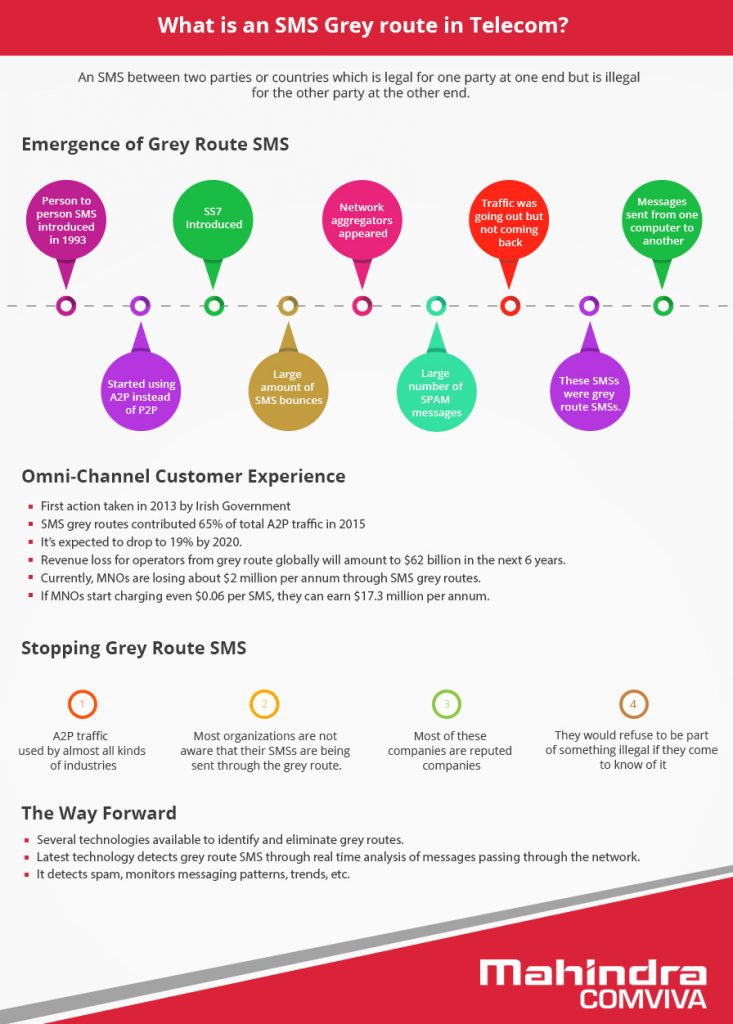The SMS Grey route is a term gaining popularity in the telecom world. But what is it? Well, the word grey is the key. Grey route SMS refers to an SMS between two parties or countries which is legal for one party at one end but is illegal for the other party at the other end. It is basically a way of sending SMS where two operators or entities do not have a commercial relationship or agreement. Well, they may lead to contravention of laws or terms and may lead to an offense case in some countries.
A good example of a grey route SMS is the Application to Person (A2P) traffic where messages are generated automatically through a sim but are used for Person to Person (P2P) uses. The advantage of this is that a large amount of traffic can be generated at a relatively low cost and send to P2P users.
On a more borderline case, the grey route might also refer to a few SS7 route SMSs. SS7 is usually used by operators to send each other P2P traffic through the international signaling network. However, when this network is used for exchanging A2P traffic without any commercial agreement, in some cases, the same can be considered as grey route as well.
Emergence of SMS Grey Route
When person to person SMS was introduced, somewhere around 1993, the global signaling system SS7 was introduced to enable person to person traffic. Slowly, there appeared a group of people, who called them network aggregators, who started exchanging messages between each other, across the globe. These were mostly P2P messages, however, there was a difference. Instead of using the P2P messaging system, they were using the A2P messaging system i.e. the messages were not sent from one person to another person, instead, they were sent from one computer to another. Although this looks like a clever idea, there was an issue with it. The cellular networks identified a large volume of traffic going to their individual subscribers, but hardly any traffic coming back. Moreover, there was a huge amount of bounces in these SMSs resulting in massive revenue loss. At that time, the amount of SPAM messaging was also extremely high. These SMSs thus started to be coined as grey route SMS.

The current situation of SMS Grey Route
The first action against SMS grey route was taken in the year 2013 by Irish Network Operators. They started separating grey route SMS from legitimate ones and started shutting down grey route SMS. Other countries were soon to follow. The cleaning drive has resulted in the removal of SPAM messages and delivery of the right messages in the right inbox.
Today, SMS grey routes contributed 65% of total A2P traffic in 2015 but that is expected to drop to 19% by 2020. It has also been estimated that the revenue loss for operators from grey route globally will amount to $62 billion in the next 6 years. Currently, MNOs are losing about $2 million per annum through SMS grey routes. If MNOs start charging even $0.06 per SMS, they can earn $17.3 million per annum.
Stopping the Grey Route
These are alarming figures and the operators are aware of that. A2P traffic is used by almost all kinds of industries today financial services, media, ecommerce, lifestyle, etc. In most cases, the organizations are not aware that their SMSs are being sent through the grey route. Many of the organizations using grey route are reputed companies and if they come to know that their SMSs are being routed through the illegal route, they would refuse not want to be a part of it. This is where lies the biggest opportunities for telecom operators. If they can find the grey traffic through algorithms and inform the users about it, much of their problem will be solved. While cost is an important factor, brand value would rank higher. The users will definitely stop using the grey route for contacting customers.
Today, several technologies are available to identify and eliminate grey routes. The latest technology detects grey route SMS through real time analysis of messages passing through the network. The technology not only detects spam, but also monitor messaging patterns, trends, etc. Eliminating SMS grey routes is an important aspect of operations of the service providers and significant priority is being given to stop revenue leakage through SMS grey routes.
